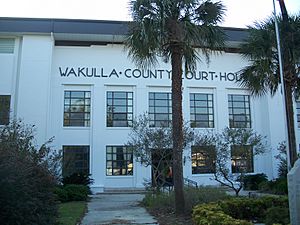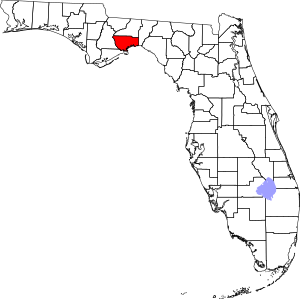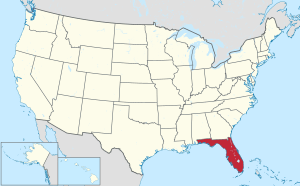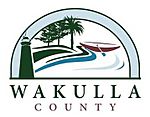Wakulla County, Florida facts for kids
Quick facts for kids
Wakulla County
|
||
|---|---|---|

Wakulla County Courthouse
|
||
|
||

Location within the U.S. state of Florida
|
||
 Florida's location within the U.S. |
||
| Country | ||
| State | ||
| Founded | March 11, 1843 | |
| Named for | Wakulla River | |
| Seat | Crawfordville | |
| Largest city | Sopchoppy | |
| Area | ||
| • Total | 736 sq mi (1,910 km2) | |
| • Land | 606 sq mi (1,570 km2) | |
| • Water | 129 sq mi (330 km2) 17.6%% | |
| Population | ||
| • Estimate
(2019)
|
33,739 | |
| • Density | 55/sq mi (21/km2) | |
| Time zone | UTC−5 (Eastern) | |
| • Summer (DST) | UTC−4 (EDT) | |
| Congressional district | 2nd | |
Wakulla County is a county located in the Big Bend region in the northern portion of the U.S. state of Florida. As of the 2010 census, the population was 30,776. Its county seat is Crawfordville.
Wakulla County is part of the Tallahassee, FL Metropolitan Statistical Area.
Wakulla County has a near-absence of any municipal population, with two small municipalities holding about 3% of the population. The county seat, Crawfordville, is one of only two unincorporated county seats among Florida's 67 counties.
History
First Spanish period
In 1528, Panfilo de Narvaez found his way to what would be Wakulla County from the future Pinellas County, Florida, camping at the confluence of the Wakulla and St. Marks rivers. Narvaez determined this was a very suitable spot for a fort. In 1539, Hernando de Soto's expedition passed through La Florida with a similar route.
The Fort San Marcos de Apalache began with a wooden fort in the late 1600s. The vicinity around the fort was not settled until 1733. Spanish colonial officials began constructing a stone fort, which was unfinished in the mid-1760s when Great Britain took over.
British period
The British divided Florida into East Florida, which included present-day Wakulla County, and West Florida. The boundary was the Apalachicola River; at that time, West Florida extended all the way to the Mississippi River. Twenty years later when the Spanish returned, they kept the East and West divisions, with the administrative capitals remaining at St. Augustine and Pensacola, respectively.
Second Spanish period
The area to become Wakulla County was an active place in the early 19th century. A former British officer named William Augustus Bowles attempted to unify and lead 400 Creek Indians against the Spanish outpost of San Marcos, capturing it. This provoked Spain, and a Spanish flotilla arrived some five weeks later to restore control.
In 1818, General Andrew Jackson invaded the area, capturing Fort San Marcos. Two captive British citizens, Robert Ambrister and Alexander Arbuthnot, were tried, found guilty of inciting Indian raids, and executed under Jackson's authority – causing a diplomatic nightmare between the U.S. and Britain. The U.S. Army garrison of 200 infantry and artillery men occupied the fort for the better part of a year (1818-1819).
In 1821, Florida was ceded to the United States and Fort St. Marks, as the Americans called it, was again garrisoned by U.S. troops.
Florida's territorial period
In 1824, the fort was abandoned and turned over to the Territory of Florida.
By 1839, the fort was returned to the Federal government and a merchant marine hospital was built. The hospital provided care for seamen and area yellow fever victims.
American forts in Wakulla County
- 1840 - Camp Lawson, northwest of Wakulla and northeast of Ivan, on the St. Marks River. A log stockade also known as Fort Lawson (2).
- 1841-1842 - Fort Many located near Wakulla Springs.
- 1839 - Fort Number Five (M) located near Sopchoppy.
- 1839-1843 - Fort Stansbury was located on the Wakulla River 9 miles (14 km) from St. Marks.
- 1841-1843 - Fort Port Leon. Abandoned after a hurricane destroyed it. Site was later used for a CSA Army artillery battery.
- 1839 - James Island Post located on James Island.
Source: Florida Forts
Antebellum Wakulla
Wakulla County was created from Leon County in 1843. It may (although this is disputed) be named for the Timucuan Indian word for "spring of water" or "mysterious water." This is in reference to Wakulla County's greatest natural attraction, Wakulla Springs, which is one of the world's largest freshwater springs, both in terms of depth and water flow. In 1974, the water flow was measured at 1.23 billion US gallons (4,700,000 m3) per day—the greatest recorded flow ever for a single spring.
In an 1856 book, adventurer Charles Lanman wrote of the springs: Another possible origin for the name Wakulla, not as widely accepted, is that it means "mist" or "misting", perhaps in reference to the Wakulla Volcano, a 19th-century phenomenon in which a column of smoke could be seen emerging from the swamp for miles.
The town of Port Leon was once a thriving cotton-shipping hub, with a railroad that carried over 50,000 tons of cotton a year to be put on ships, usually for shipment direct to Europe. Port Leon was the sixth-largest town in Florida, with 1,500 residents. However, a hurricane and the accompanying storm surge wiped out the entire town. New Port (today known as Newport) was built two miles (3 km) upstream but never quite achieved the prosperity of Port Leon.
Civil War
During the Civil War, Wakulla County was blockaded from 1861 to 1865 by a Union Navy squadron at the mouth of the St. Marks River. Confederates took the old Spanish fort known as San Marcos de Apalache, or Fort St. Marks, and renamed it Fort Ward.
The Battle of Natural Bridge eventually stopped the Union force that intended to take Fort Ward and nearby Tallahassee, the only Confederate state capital which had not been captured. The Union was not able to land all of its forces, but they still outnumbered the Confederates; who chose to make their stand at a place where the St Marks River goes underground—the "Natural Bridge' referred to. However, the Confederate Army had over a day to prepare their defenses, and the Union Army retreated. Most of the dead were African-American Union soldiers.
20th century & beyond
In Gloria Jahoda's book, The Other Florida, she writes movingly of the extreme poverty of Wakulla County from the early 1900s to 1966, when Wakulla still had no doctor and no dentist, few stores, and a county newspaper produced just once a month on a mimeograph machine.
Today, Wakulla has several doctors and dentists, several supermarkets and big-box retailers, a golf resort, and a thriving seafood business.
Etymology
The name Wakulla is corrupted from Guacara. Guacara is a Spanish phonetic spelling of an original Indian name, and Wakulla is a Muskhogean pronunciation of Guacara. The Spanish Gua is the equivalent of the Creek wa, and as the Creek alphabet does not exhibit an "R" sound, the second element cara would have been pronounced kala by the Creeks. The Creek voiceless "L" is always substituted for the Spanish "R". Thus the word Guacara was pronounced Wakala by the Seminoles who are Muskhogean in their origin and language.
Since Wakulla was probably a Timucuan word, it is unlikely that its meaning will ever be known. It may contain the word kala which signified a "spring of water" in some Indian dialects.
Geography
According to the U.S. Census Bureau, the county has a total area of 736 square miles (1,910 km2), of which 606 square miles (1,570 km2) is land and 129 square miles (330 km2) (17.6%) is water.
Adjacent counties
- Leon County - north
- Liberty County - west
- Franklin County - southwest
- Jefferson County - east
National protected areas
- Apalachicola National Forest (part)
- St. Marks National Wildlife Refuge (part)
State and local protected areas
Demographics
| Historical population | |||
|---|---|---|---|
| Census | Pop. | %± | |
| 1850 | 1,955 | — | |
| 1860 | 2,839 | 45.2% | |
| 1870 | 2,506 | −11.7% | |
| 1880 | 2,723 | 8.7% | |
| 1890 | 3,117 | 14.5% | |
| 1900 | 5,149 | 65.2% | |
| 1910 | 4,802 | −6.7% | |
| 1920 | 5,129 | 6.8% | |
| 1930 | 5,468 | 6.6% | |
| 1940 | 5,463 | −0.1% | |
| 1950 | 5,258 | −3.8% | |
| 1960 | 5,257 | 0.0% | |
| 1970 | 6,308 | 20.0% | |
| 1980 | 10,887 | 72.6% | |
| 1990 | 14,202 | 30.4% | |
| 2000 | 22,863 | 61.0% | |
| 2010 | 30,776 | 34.6% | |
| 2019 (est.) | 33,739 | 9.6% | |
| U.S. Decennial Census 1790-1960 1900-1990 1990-2000 2010-2015 2019 |
|||
As of the census of 2000, there were 22,863 people, 8,450 households, and 6,236 families residing in the county. The population density was 38 people per square mile (15/km2). There were 9,820 housing units at an average density of 16 per square mile (6/km2). The racial makeup of the county was 86.10% White, 11.51% Black or African American, 0.59% Native American, 0.25% Asian, 0.03% Pacific Islander, 0.29% from other races, and 1.23% from two or more races. 1.94% of the population were Hispanic or Latino of any race.
There were 8,450 households, out of which 35.60% had children under the age of 18 living with them, 57.10% were married couples living together, 12.40% had a female householder with no husband present, and 26.20% were non-families. 22.00% of all households were made up of individuals, and 7.00% had someone living alone who was 65 years of age or older. The average household size was 2.57 and the average family size was 2.99. In the county, the population was spread out, with 25.60% under the age of 18, 7.60% from 18 to 24, 31.70% from 25 to 44, 24.70% from 45 to 64, and 10.30% who were 65 years of age or older. The median age was 37 years. For every 100 females, there were 107.30 males. For every 100 females age 18 and over, there were 106.80 males.
The median income for a household in the county was $37,149, and the median income for a family was $42,222. Males had a median income of $29,845 versus $24,330 for females. The per capita income for the county was $17,678. About 9.30% of families and 11.30% of the population were below the poverty line, including 15.40% of those under age 18 and 15.10% of those age 65 or over.
Transportation
Roads
Although there are no Interstate highways in Wakulla County, several major routes pass through the area, including U.S. Route 98 and U.S. Route 319. Other important roads in the county include State Road 267, State Road 363 and County Road 375.
Railroads
No railroads currently operate within Wakulla County.
In the past the Georgia, Florida and Alabama Railroad passed through Sopchoppy on its route between Tallahassee and Carrabelle until its abandonment in 1948; that portion of the line was referred to as the Sumatra Leaf Line, referring to a tobacco grown in the area. South of Sopchoppy the line followed H.T. Smith Road. The railroad bridge crossing the Ochlocknee River at MacIntyre still exists as pilings blocking all but a portion of the river on the south side. while the Tallahassee Railroad, the first railroad in Florida, was abandoned by its successor, the Seaboard Coast Line Railroad, in 1983.
Airports
The Wakulla County Airport (2J0), located south of Panacea, is a small public-use airport with a single 2,600-foot (790 m), north–south turf runway.
Seaports
St. Marks is a small commercial seaport. Panacea and Ochlockonee Bay also support small fishing fleets.
Communities
Cities
Census-designated places
Other unincorporated communities
- Arran
- Buckhorn
- Curtis Mills
- Hyde Park
- Medart
- Port Leon
- Newport
- Sanborn
- Shadeville
- Shell Point
- Smith Creek
- Spring Creek
- Wakulla
- Wakulla Beach
Education
Wakulla County is served by the Wakulla school district with the following schools:
- Crawfordville Elementary School
- C.O.A.S.T. Charter School
- Medart Elementary School
- Shadeville Elementary School
- Riversink Elementary School
- Riversprings Middle School
- Wakulla Middle School
- Wakulla High School
- Wakulla Christian School
The former Sopchoppy Elementary School now serves as the Sopchoppy Education Center, a Pre-K, adult, and second chance school.
The former Shadeville High School served African-American students from 1931 to 1967.
Library
The Wakulla County Public Library is the main library of Wakulla County and is a part of the Wilderness Coast Public Libraries.
See also
 In Spanish: Condado de Wakulla para niños
In Spanish: Condado de Wakulla para niños


